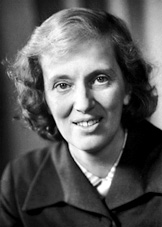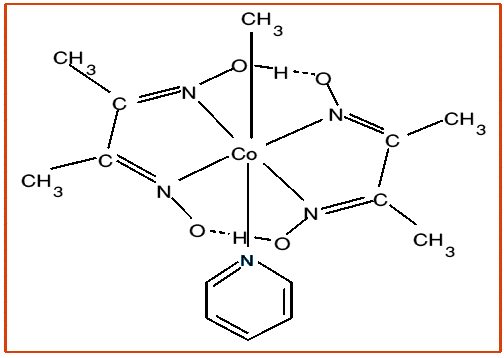
During 2014, scientists have been celebrating the International Year of Crystallography although it is actually 101 years since X rays were first used to determine the arrangement of atoms in a crystal (see Chemistry 1913 – a centenary of chemistry). This year is also the fiftieth anniversary of the Nobel Prize for Chemistry won by Dorothy Crowfoot Hodgkin for her contributions to the field. Hodgkin’s award celebrated her skill at determining the structures of complex molecules but it is also important as she is the only British woman to have been awarded a Nobel Prize. As well as discovering how she came to fame we can ask why she is still unique.
In 1913 the Bragg team of father and son determined the structure of sodium chloride and following the First World War many other inorganic compounds were investigated. Organic compounds also form crystals and William Bragg was among the first to take X ray pictures of organic crystals. One of Bragg’s assistants at the Royal Institution was J.D Bernal. Bernal worked out the hexagonal plate structure of graphite. Kathleen Lonsdale, one of the growing number of women scientists, also worked with Bragg and proved that benzene was a planar ring of six carbon atoms. In 1927 Bernal moved to Cambridge University to set up his own X ray Crystallography department investigating biological molecules. In 1932 he was joined by a young Dorothy Crowfoot.
Dorothy was born in 1910 in Cairo, Egypt where her father worked in the education service for the British Government. In 1914, at the start of the war, Dorothy was brought home to England to attend school but her parents remained in North Africa. Many schools did little to encourage girls into science but Dorothy’s girls’ school had a female chemistry teacher who inspired her. Dorothy excelled in schoolwork and in 1928 earned a place at Somerville College, Oxford. Women had only been awarded degrees at the university since 1920 and many male fellows were not pleased about teaching women. Life was very different then for female students with chaperones, strict curfews and little contact with male students. Dorothy studied chemistry and in the fourth year research project decided to pursue X ray crystallography. Oxford had just acquired its first X ray camera. Dorothy was given the task of finding the structure of a simple organo-metallic substance – a compound containing a metal and an organic group. Despite problems with the equipment Dorothy succeeded and in 1932 achieved a First Class chemistry degree, only the third woman to do so.
Dorothy moved to Cambridge to join Bernal’s team and took up his research into the structure of biological molecules. Shortly after she arrived however, the authorities in Oxford invited her back to set up and run an enlarged crystallography department. She stayed with Bernal for two years, learning a great deal, before she returned to Somerville College. Her new job involved teaching as well as research.
Dorothy decided to investigate insulin which had recently been discovered as the substance that controls the concentration of sugar in the blood. Taking insulin keeps sufferers of diabetes healthy. Insulin was a much more complex molecule that the others Dorothy had studied. It is a protein with hundreds of atoms bonded together. New mathematical tools had been developed, by Kathleen Lonsdale amongst others, that allowed the pattern of spots on the X ray photographs to be interpreted so that the arrangement of the atoms could be deduced. It was a long and difficult task. First Dorothy had to get some good crystals to take the X ray photographs. Then she had to measure the position and relative brightness of the spots and do the calculations. It would take her until 1969.
In 1937 she met Thomas Hodgkin and they were married within the year. Her first child, Luke was born in 1939. Dorothy continued to work alongside her family life. As well as insulin she was investigating other proteins. Knowing the structure of these substances helps to explain the vital jobs they do in living organisms and may suggest how they can be synthesised.
Penicillin was the first antibiotic and was developed during the 2nd World War by the Oxford team of Florey and Chain. Dorothy was asked to determine the structure and succeeded in 1945. It was then the largest molecule to have its structure worked out.

B12 is the vitamin that helps the body make use of iron and prevents anaemia. Dorothy succeeded in working out its structure in 1956. By this time Dorothy was one of the leading X ray crystallographers in the world. In the 1950s and 60s computers began to speed up the thousands of calculations needed to determine structures and the work on insulin and other molecules accelerated. In 1964 she was awarded the Nobel Prize for chemistry for her study of proteins and in particular for deducing the structures of penicillin and B12.
Dorothy Crowfoot Hodgkin retired in 1977 but continued to work in science. She died in 1994 hailed as one of the founders and leaders of the science of X ray crystallography.
Why does Dorothy Hodgkin remain the UK’s only female Nobel Prize winner in the sciences? Nobel Prizes are usually awarded ten to thirty years after a notable piece of research was reported. The winners have spent a long time in their scientific careers. In the first half of the twentieth century few women were encouraged into the sciences and even fewer continued in research after marriage. Taking a break to have children did, and still does, cause a break in a scientific career which is difficult to make up. Although their number is increasing, few women make it to professorships and leadership of research teams. Their names are not the ones that are linked with the discoveries that draw the attention of the Nobel Prize panels. The situation should have changed since the 1980s when women achieved equal rights but progress is slow. Although the number of girls studying sciences at A level has increased perhaps the fact that more girls than boys train to become medical doctors and vets means that a lower proportion are carrying out scientific research. Perhaps the demands of family life are still affecting women more than men. Let us hope that a woman will join Dorothy Hodgkin soon.
Bibliography
Dorothy Hodgkin: A Life, Georgina Ferry pub. Granta 1998.
Oxford Dictionary of Scientists, pub.OUP
http://www.nobelprize.org/nobel_prizes/chemistry/laureates/1964/
Activities
- Find out what the following terms used in the article mean and design a poster to display them: organic, protein, X rays, crystallography.
- Find out more about the biological function of insulin, vitamin B12 and penicillin.
- Dorothy Hodgkin’s Nobel prize was awarded the year after the prize awarded for the discovery the structure of DNA which used X ray photographs made by Rosalind Franklin. Franklin died in 1958 so could not be awarded the prize. Kathleen Lonsdale was never awarded a Nobel Prize but was the first female Fellow of the Royal Society. (a) Find out more about the lives and work of Dorothy Hodgkin, Kathleen Lonsdale and Rosalind Franklin. (b) Discuss the reasons why it is seems that there is a larger proportion of well-known women involved in X ray crystallography than in science generally.
- Explain why protein structures can now be worked out in days while it took Dorothy Hodgkin 35 years to complete the structure of insulin.
- Discuss ways of achieving a more even distribution of Nobel Prizes between men and women in the future.
Peter Ellis



